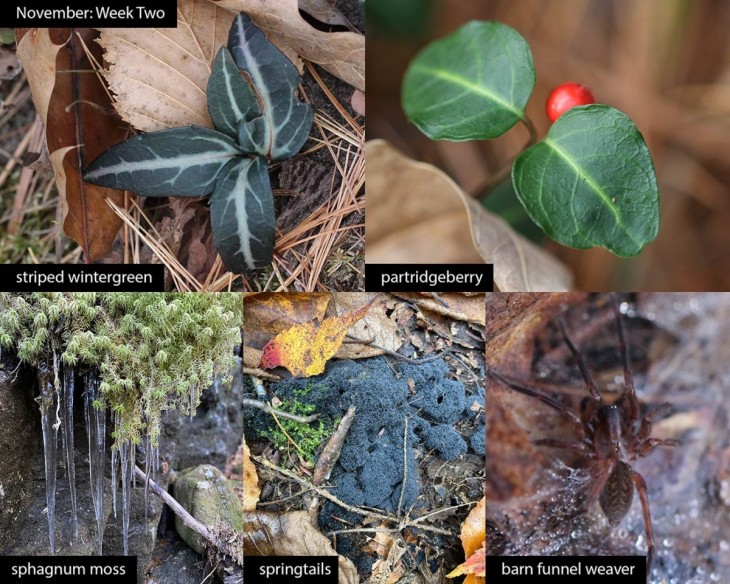This week in the woods, we start with where we can find some lingering green. When many other species’ leaves have browned or fallen away, striped wintergreen (Chimaphila maculata) becomes especially noticeable. Also known as spotted wintergreen, prince’s pine, and pipsissewa, this small plant in the blueberry family is relatively uncommon in the Upper Valley, but you may find it growing in patches of sandy, well-drained upland forest, with better luck on the New Hampshire side of the river. Look for clusters of dark-green leaves with white midrib stripes. Striped wintergreen bears no relation to the true wintergreen plant (Gaultheria procumbens), which foragers can read more about in Benjamin Lord’s 2017 piece from the Northern Woodlands archives.
The partridgeberry proves an easier evergreen find. This creeping, round-leaved herb grows close to the ground in the rich soils of deciduous forests, tolerating shade between spring and fall. It may prefer inclines and stream banks in part because leaf litter is more likely to fall or wash away in these settings, rather than bury partridgeberry and block its light. This species has an unusual reproductive approach in which it bears two fuzzy white flowers, which must both be pollinated in order to fuse and produce a single scarlet berry. Ruffed grouse, wild turkey, red fox, raccoon, and deer all make meals of this fruit, and humans can, too.
While hiking in the White Mountain National Forest in Franconia, New Hampshire, Editor Meghan McCarthy McPhaul found these icicles emerging from below a species of sphagnum moss – going pale but still holding green. As the ice indicates, these soft, spongy mosses prefer high-moisture environments; some can absorb up to 25 times their weight in water.
More sphagnum, in a beech stand closer to the Northern Woodlands office in Lyme, hosted these springtails, also called snow fleas. The hexapods (which are no longer listed as insects) rank among the most abundant invertebrates on the forest floor, where they consume rotting leaf litter, algae, bacteria, and fungi. Some mosses use a chemical scent to recruit microarthropods to transport sperm from male to female plants; a 2021 study showed that moss reproductive rates increased fivefold in the presence of springtails.
As prey, springtails also support numerous species of forest-dwelling spiders, including the barn funnel weaver – familiar to us as the domestic house spider and distributed nearly worldwide. We spotted this predator lying in wait under a log in Fairlee, Vermont.
What have you noticed in the woods this week? Submit a recent photo for possible inclusion in our monthly online Reader Photo Gallery.


